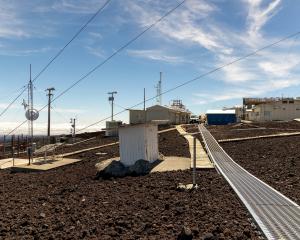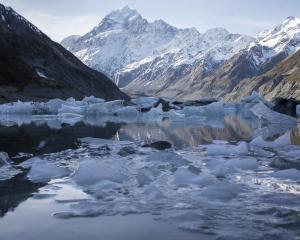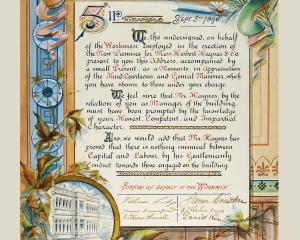Cross-pollination between art and science has been taken almost literally in one work in a new exhibition, writes Tom McKinlay.
Art and science are back on the same page, or at least in the same space in the exhibition ''Art and Light'', which opened last night at Otago Museum's H. D. Skinner Annex.
Through the medium of art, the science of pollinating herbs on the Auckland Islands, Dunedin's special place in the world of lightning and the light and dark of Parkinson's research are illuminated, among other things.
And in the process, the practice of art has discovered new focus, says Dr Peter Stupples, one of the exhibition's principal organisers.
It is the third such exhibition, following last year's ''Art and Anatomy'' exhibition and 2013's ''Art in Neuroscience'', each the product of collaborations between artists associated with the Dunedin School of Art and scientists at the University of Otago.
And this time, the cross-pollination involved has been taken almost literally in at least one work.
The scientist involved, university botanist Dr Janice Lord, has been working on the ''luxurious herbs'' that grow in the Auckland Islands, south of New Zealand, relates Dr Stupples, an art historian and theoretician at the art school.
''Nobody knew how they pollinated until [Dr Lord] went down there and almost by accident went out one night with a torch and found that these herbs were covered with wetas, which were actually pollinating the flowers at night in the dark,'' Dr Stupples explains.
The light in this case then, was the infrared light from Dr Lord's torch, which was seized upon by artist Sue Taylor.
''Now one of our artists has taken that up and we have some beautiful embroidered wetas on plants as a result of that,'' says Dr Stupples.
''So light works in different ways; this was accidental use of infrared that made a scientific discovery which our artist can take up from there.''
Light is this year's theme courtesy of Unesco, which declared 2015 the International Year of Light and Light-based Technologies ''to promote sustainable development and provide solutions to global challenges in energy, education, agriculture and health''.
Dr Stupples says the collaborations have ranged across ''a whole raft'' of university departments with an interest in research on light in one way or another.
''They range from the physics department, which is one of the main contributors, to the Dodd-Walls Centre for Photonic and Quantum Technologies, the anatomy department and other physiological departments and other departments at the university.
''The artists don't illustrate the science. It is some art that comes out of that interaction between scientist and artist,'' Dr Stupples explains.
This year, 17 artists associated with the art school and 12 scientists have worked together in different combinations over an eight-month period.
For the science community it is an opportunity to have their work communicated to the public in a different way.
For the artist, it provides a focus for their work, which some of them welcomed, Dr Stupples says.
''Artists often would like a focus for their work, for their work to be useful. So we have actually had one or two of these artists who have been in all three of the exhibitions because they found it a very good way of focusing the way in which they work.''
When the first exhibition, ''Art in Neuroscience'', was launched there was some scepticism.
''How would it work? Would the artists be able to work with scientists? What sort of a relationship would they have? We found that it did work but always differently in each particular case.
"In some cases the artist might meet the scientist once or twice and something would come of it, whereas in other cases the artist and the scientists have actually worked together very regularly and have become friends and had a creative relationship.''
It has been the same this time, some artists working very closely with the scientists over the eight-month period, others having a comparatively cursory relationship, but nevertheless creating something from it.
For the scientists, it has been an opportunity to encounter the work of others.
''I think many of the scientists who have been working on their research project have their nose to the microscope, as it were, and don't really see their own science outside their own very narrow field.
"And when they actually meet, because we have regular meetings with the artists and scientists all of them together, the scientists then are not seeing just their own field but other scientists' fields as well and find they get interested and excited by it and they see the art as well as opening up the way in which they can think about their own discipline.''
Among other collaborations is one between Prof Craig Rodger, a lightning researcher at the university's physics department, computer scientist Dr Steven Mills, and David Green, an art school lecturer in photography and the electronic arts.
The resulting work involves lightning strikes playing on people at the exhibition, Dr Stupples says.
''And they will become their own artwork.''
An interaction between Dr Alex Doronin, of the university's biophotonics and biomedical imaging research group, and Natallia Trayann, an artist with an interest in fashion, has led to the creation of a garment incorporating electronic filaments.
When viewed through something like 3-D glasses, the garment will radiate different colours of polarised light.
In another, artist James Bellaney worked with Parkinson's researcher Dr Lousie Parr-Brownlie, of the university's anatomy department.
In the course of her research, Dr Parr-Brownlie looks at the way in which parts of the brain ''light up'' at different times.
Having observed the process, Bellaney has completed an abstract painting, not illustrating what he saw, but using the idea of contrasting dead space and lit, or alive, space.
Sarah McKay's photography series Within the Outside, is another collaboration with Craig Rodger, inspired by the scientist's role in capturing information from the atmosphere that is invisible to the naked eye. Similarly, her images were only visible to her camera and lens.
Dr Stupples says there will be another collaborative exhibition next year, but is not saying what the theme will be.
What he is prepared to share is that there is already a queue of science researchers who would like to be involved, to see their work reinterpreted and reimagined as art.
The exhibition
• ''Art and Light'' is on in the Otago Museum H. D. Skinner Annex until August 30, daily from 10am-3pm.












